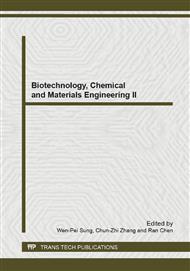p.113
p.117
p.123
p.128
p.132
p.136
p.140
p.144
p.148
Aging and Shear Rejuvenation Behavior of Printing Ink
Abstract:
The aging and shear rejuvenation behavior of a commercial printing ink have been studied experimentally using creep and oscillation modes. We observed that the printing ink has typical rheological characteristics: time-dependent, reversible and shear-thinning viscosity. Meanwhile, these properties are very strongly influenced by shear history, thus employing pre-shearing to obtain a standard test state is of vital importance. After pre-shearing, the quiescent ink undergoes structural evolution, i.e., aging, including a sol-gel (liquid-solid) transition on the early stage at room temperatures, the higher the temperature, the earlier the sol-gel transition occurs. The degree of aging and shear rejuvenation can be characterized by the waiting time after pre-shearing and the stress dependence of the power-law index. Finally, we use a time-stress superposition to obtain a universal master curve which is able to describe the aging behaviors of the printing ink. This study shows that the aging processes of printing ink for different waiting times are self similar, variation of waiting time just change the time scale and elastic modulus.
Info:
Periodical:
Pages:
132-135
Citation:
Online since:
January 2013
Authors:
Keywords:
Price:
Сopyright:
© 2013 Trans Tech Publications Ltd. All Rights Reserved
Share:
Citation:


